Mother Hippos Are Delicious Posted: 13 Aug 2013 04:00 AM PDT ![]()
I admit it, I'm one of those women who just wants to gently nibble on the cheeks of adorable babies. It seems in the hippo world though, babies want to nibble their mothers on the cheek. Link Via Cute Overload |
The Internet Actually Likes You Posted: 13 Aug 2013 03:00 AM PDT ![]()
Real-life, face-to-face relationships? Pass. Take Jim Benton's advice and plug yourself into the internet. There's an entire world that has nothing bad to say about you individually. Link |
LEGO Breaking Bad Laboratory Posted: 13 Aug 2013 02:00 AM PDT ![]()
Citizen Brick designed a laboratory playset from the TV show Breaking Bad made of 500 pieces of customized LEGO bricks, minifigs, and accessories. It's called the Superlab Playset, and you can purchase one, complete with little Walt, Gus, and Jesse. It's not cheap, but it's perfect for the ultimate Breaking Bad fan. Link -via Laughing Squid |
Plane, Out of Fuel, Makes Emergency Landing at Gas Station Posted: 13 Aug 2013 01:00 AM PDT ![]() (Photo: WUSA 9) (Photo: WUSA 9)
The single engine Piper was running out of fuel, so pilot Jerome M. Orlando headed for Shannon Airport in Spotsylvania County, Virginia. He didn't make it, though, and instead landed at a gas station lot in Fredericksburg: The plane then landed in the parking lot of the Wawa, its nose wheel folding back when it hit a curb shortly before 6 a.m., says Stanley. Virginia State Police say a mailbox and a parking sign were the only property damaged on the ground.
Link -via Jalopnik |
Animal Boot Cuffs Posted: 13 Aug 2013 12:00 AM PDT ![]()
Animal Boot Cuffs (sold individually) Fall is right around the corner. Are you looking for a fun way to bring your favorite pair of comfy boots to life? Add a pair of Animal Boot Cuffs from the NeatoShop. These adorable knitted boot cuffs are shaped like cute critters. Animal Boot Cuffs are available in: Buy them all and make it a wild set. One size fits most. Be sure to check out the NeatoShop for more great Footwear. Link |
The Star Trek Pie-Eating Contest Posted: 13 Aug 2013 12:00 AM PDT A scene from Sunday's night's Breaking Bad season premiere has been animated. This does not provide any spoilers to the series' plot, because it's a conversation about a bit of Star Trek fan fiction. I think you'll enjoy it. Link -via Uproxx |
This 388-Year Old Bonsai Survived Hiroshima Posted: 12 Aug 2013 11:00 PM PDT ![]() (Photo: Sage Ross) (Photo: Sage Ross)
This Japanese White Pine bonsai, planted in 1625, has survived the ravages of both time and atomic warfare. It was in Hiroshima, Japan when the US dropped an atomic bomb on that city on August 6, 1945. The then-owner described the experience: On that day, Shigeru said that all the family members (his grandparents and their young son-Shigeru's father) were inside their home. The bomb exploded about three kilometers (less than two miles) from the family compound. The blast blew out all the glass windows in the home, and each member of the family was cut from the flying glass fragments. Miraculously, however, none of them suffered any permanent injury. [...] The great old Japanese white pine and a large number of other bonsai were sitting on benches in the garden. Amazingly, none of these bonsai was harmed by the blast either, because the nursery was protected by a tall wall. A Japanese broadcasting company would later film the bonsai garden and report on how the wall had saved the bonsai.
Link -via Twisted Sifter |
The Grumpy King Posted: 12 Aug 2013 10:00 PM PDT ![]()
Can you feel the love tonight? "No" DeviantArt user TsaoShin made this fantastic parody of The Lion King featuring everyone's favorite grumpy little kitten, Tardar Sauce. Link Via Geekosystem |
The History of the World in One Chart Posted: 12 Aug 2013 08:00 PM PDT ![]()
In 1931, John B. Sparks created a "histomap" that distilled the history of civilization into a colorful timeline. See 4,000 years of empires rising and falling, and even though it stops after World War I, you can imagine how it would look if it were continued. The chart emphasizes domination, using color to show how the power of various “peoples” (a quasi-racial understanding of the nature of human groups, quite popular at the time) evolved throughout history.
It’s unclear what the width of the colored streams is meant to indicate. In other words, if the Y axis of the chart clearly represents time, what does the X axis represent? Did Sparks see history as a zero-sum game, in which peoples and nations would vie for shares of finite resources? Given the timing of his enterprise—he made this chart between two world wars and at the beginning of a major depression—this might well have been his thinking.
Only a portion is shown here. You can see the full, enlargeable chart at Slate. Link -via Digg |
9 Creative S'more Recipes Posted: 12 Aug 2013 07:00 PM PDT ![]()
August 10th was National S'more Day. I missed it! So I'll punish myself by eating extra s'mores today. Craftsy rounded up 9 unusual s'more recipes, including this giant s'more cake made by Ethel Rose. It serves one. Link -via Cake Spy |
Cakes for Back-to-School Posted: 12 Aug 2013 06:00 PM PDT ![]()
Cake Wrecks put together a post for back-to-school, illustrated with badly decorated cakes. There's a cake for each school subject, and more just for laughs. The cake pictured here represents math, although it may give a teacher a headache. Link |
Image Formed by Thousands of Potted Plants on a Staircase Posted: 12 Aug 2013 05:00 PM PDT ![]() (Photo: Andrea Annaloro) (Photo: Andrea Annaloro)
Every year, residents of Caltagirone, Italy honor the patron saint of the city with the Scala Flower Festival. They arrange potted plants on a grand staircase in that city to form composite images, such as these flowers made of flowers. You can see more photos at the link. Link (Translation) -via Lustik |
7 Things About Schrödinger You Didn't Know Posted: 12 Aug 2013 04:00 PM PDT So, today is Austrian physicist Erwin Schrödinger's 136th birthday and Google celebrated with with a clever Schrödinger's Google Doodle: ![]()
We bet that whenever you hear the word "Schrödinger," you immediately think of Schrödinger's Cat. But how much do you actually know about the man behind the famous paradox? Here are some of the neatest facts about Erwin Schrödinger. No physics involved, we promise! 1. The Challenge That Caused Schrödinger to Figure out Wave Mechanics Swiss physicist Felix Bloch recounted the story of how wave mechanics came to be: One day, Nobel laureate Peter Debye said, "Schrödinger, you are not working right now on very important problems anyway. Why don't you tell us some time about that thesis of de Broglie, which seems to have attracted some attention." And so Schrödinger did. He gave a talk about how French physicist Louis de Broglie postulated that matter also has wave properties, but Debye dismissed the talk as "childish," pointing out that "to deal properly with waves, one had to have a wave equation." Schrödinger thought about it and soon after left his wife for a two-and-a-half-week vacation at a villa in the Swiss Alps. He took only de Broglie's thesis, an old Viennese girlfriend (whose identity remains a mystery until today), and two pearls. After, uh, rigorously "consulting" with the girlfriend for inspiration, Schrödinger shoved the pearls into his ears to get himself some peace and quiet, and set to work on wave mechanics. By the next talk, Schrödinger said, "My colleague Debye suggested that one should have a wave equation; well, I have found one!" Years later, Bloch approached Debye and asked him about the encounter. Debye claimed that he had forgotten, but Bloch thought that he was regretful that he goaded Schrödinger into working out the formula rather than doing it himself. Regardless, Debye turned to Bloch and said, "Well, wasn't I right?" 2. The Schrödinger Banknote ![]()
A physics post-doc once said to me that "there's no money in physics." That may be true, but there sure is physics in money! Behold, the Schrödinger Banknote, circa 1983. 3. Schrödinger Wasn't Just All About Physics When he's not busy winning the Nobel prize for Physics and other physical activities (see below), Schrödinger loved to "ski, skate, swim, [and] climb mountains." ![]() 4. Schrödinger's Duality of Marriage 4. Schrödinger's Duality of Marriage
Whether Schrödinger's Cat lives or dies may be a matter of quantum probabilities, but there's no mystery about Schrödinger's marriage: he openly had many mistresses, including Hilde March, the wife of his physics colleague Arthur March. But don't worry about Schrödinger's wife Anny - Arthur regularly bedded her as well. 5. Schrödinger Came Back ... as a Character on Futurama ![]()
Schrödinger came back to life in an episode of Futurama, where he broke the law by going 15 miles per hour over the speed of light while carrying a box with "a cat, some poison, and a cesium atom" inside. From The Infosphere, a Futurama wiki: [Circuit City. Fry and URL are pointing guns at Schrödinger.]
Fry: DNA and career chip, please.
[Schrödinger offers his hand and Fry pierces it with a gun that projects a hologram reading NNY DMV, ERWIN SCHRÖDINGER and showing Schrödinger's profile photograph.]
URL: Erwin Schrödinger, huh? What's in the box, Schrödinger?
Erwin Schrödinger: Um... A cat, some poison, und a cesium atom.
Fry: The cat! Is it alive or dead? [Schrödinger is not given the time to reply.] Alive or dead?! [URL pushes Schrödinger against his car's door, alarming him.]
URL: Answer him, fool.
Erwin Schrödinger: It's a superposition of both states until you open it and collapse the wave function.
[Fry enters the car.]
Fry: Says you.
[Fry opens the box and a cat jumps out of it, attacking him. Fry screams. URL takes a close look at the box.]
URL: There's also a lotta drugs in there.
6. Schrödinger on Quantum Mechanics He Helped Build: "I Don't Like It" So, what did the eminent physicist actually think of the probability interpretation of quantum mechanics? He said, "I don't like it, and I'm sorry I ever had anything to do with it." Later, physicist Gregor Wentzel told him, "Schrödinger, it is most fortunate that other people believe more in your equation than you do." 7. Schrödinger's Cat is Schrödinger's Way to Make Fun of Quantum Mechanics ![]()
Look Out Schrodinger's Cat, It's A Trap! by Mike Jacobsen
So, back to Schrödinger's Cat, remember him? It's ironic that Schrödinger's famous thought experiment was actually proposed to make fun of the strange nature of quantum physics. In 1935, Albert Einstein, Boris Podolsky, and Nathan Rosen came up with an article that highlights the strange nature of quantum entanglement - that a quantum system's state is not defined until it is actually measured. So, Schrödinger wrote: One can even set up quite ridiculous cases. A cat is penned up in a steel chamber, along with the following device (which must be secured against direct interference by the cat): in a Geiger counter, there is a tiny bit of radioactive substance, so small, that perhaps in the course of the hour one of the atoms decays, but also, with equal probability, perhaps none; if it happens, the counter tube discharges and through a relay releases a hammer that shatters a small flask of hydrocyanic acid. If one has left this entire system to itself for an hour, one would say that the cat still lives if meanwhile no atom has decayed. The psi-function of the entire system would express this by having in it the living and dead cat (pardon the expression) mixed or smeared out in equal parts. It is typical of these cases that an indeterminacy originally restricted to the atomic domain becomes transformed into macroscopic indeterminacy, which can then be resolved by direct observation. That prevents us from so naively accepting as valid a "blurred model" for representing reality. In itself, it would not embody anything unclear or contradictory. There is a difference between a shaky or out-of-focus photograph and a snapshot of clouds and fog banks.
See also: Schrödinger T-shirt designs from the NeatoShop |
The Solar System Looks Great On You Posted: 12 Aug 2013 03:00 PM PDT ![]()
Why wear your heart on your sleeve when you can wear your whole solar system around your neck? This beautiful piece by Etsy seller LeBeadeau sort of reminds me of the galaxy on Orion's Belt from Men in Black -only a smaller part of space in a larger package. Link |
11 Things We No Longer See in Movie Theaters Posted: 12 Aug 2013 02:00 PM PDT ![]() Once upon a time, movie theaters offered a "fancy night out" experience. You no longer see 50¢ tickets, but back then you got an awful lot for your money, whatever the price. Remember when almost all theaters had uniformed ushers? Once upon a time, movie theaters offered a "fancy night out" experience. You no longer see 50¢ tickets, but back then you got an awful lot for your money, whatever the price. Remember when almost all theaters had uniformed ushers?
Those gallant men and women who escorted you to your seats at the cinema used to dress in more finery than a decorated soldier. But that was at a time when movie ushers did much more than tear tickets and sweep up spilled popcorn; they kept an eye out for miscreants attempting to sneak in without paying, offered a helpful elbow to steady women walking down the steeply inclined aisle in high-heeled shoes, and were quick to “Shhh!” folks who talked during the movie. Ushers carried small flashlights to guide patrons who arrived after the movie had started, and they were also the ones who maintained order when the film broke and the audience grew ornery.
Most of us are only familiar with uniformed ushers only because they are depicted in classic films and cartoons. But there are some modern theaters that go all out to recreate those memories with ushers and the other theater amenities on the list at mental_floss. Link |
Hello Kitty Japanimation Crossbody Bag Posted: 12 Aug 2013 01:00 PM PDT ![]()
Hello Kitty Japanimation Crossbody Bag Attention Hello Kitty fans. Are you longing for the purr-fect purse that marries your love of anime and Hello Kitty? Behold the Hello Kitty Japanimation Crossbody Bag from the NeatoShop. This vibrant purse features Hello Kitty drawn in anime style with colorful graphics and stylized eyes. The bag comes with both padded handles and a crossbody strap for easy toting. Hello Kitty Japanimation Necklace also available. Buy both and make it a super stylish set. Be sure to check out the NeatoShop for more great Bags and Totes. Link |
<i>My Little Pony</i> Ties Posted: 12 Aug 2013 01:00 PM PDT ![]()
Got a job interview coming up? You'd better dress to impress. One way to do so would be to wear one of David Hajari's My Little Pony ties. You'd definitely stand out to the interviewers. Just be sure to choose the right tie for the right company. Some firms have Rainbow Dash or Luna corporate cultures. Others, though, are rather Derpy. Link |
Love and OCD Posted: 12 Aug 2013 12:00 PM PDT ![]() (YouTube link) (YouTube link)
What's it like to fall in love when you are suffering from Obsessive-Compulsive Disorder? Neil Hilborn told the story last month at the 2013 Rustbelt Regional Poetry Slam. You might laugh, but eventually you'll tear up a little. Contains one NSFW word. -via Viral Viral Videos |
Questions In Need of Answers - No. 5: What Non-Traditional Medical Cures Actually Work? Posted: 12 Aug 2013 11:00 AM PDT ![]() After years of suffering through various types of ailments, using traditional prescriptions from traditional Western doctors, and going through various procedures at Dr.'s offices and Out-Patient facilities, I felt like I was at a dead end... like nothing worked for some of these persistent problems. Then I discovered the magic of ACV, or apple cider vinegar, which has, in some cases, cured my problems and in other cases greatly reduced the issue. Now, let's be clear here, I am not a medical doctor and Neatorama does not suggest that ACV is an actual "drug" that contains "magic" properties. Nor are we in cahoots with any ACV manufacturer. After years of suffering through various types of ailments, using traditional prescriptions from traditional Western doctors, and going through various procedures at Dr.'s offices and Out-Patient facilities, I felt like I was at a dead end... like nothing worked for some of these persistent problems. Then I discovered the magic of ACV, or apple cider vinegar, which has, in some cases, cured my problems and in other cases greatly reduced the issue. Now, let's be clear here, I am not a medical doctor and Neatorama does not suggest that ACV is an actual "drug" that contains "magic" properties. Nor are we in cahoots with any ACV manufacturer.
But I will say that it has changed my life. Without going into any great details of what the issues were/are, I can say that ACV has helped me with skin problems and stomach/intestinal problems. And you can read up on what others believe are the benefits of ACV here. Soooo, my question this week is: 1) What persistent or otherwise irksome health issues have you cured or eased with non-traditional treatments, medicines or "magic potions" ? In other words: What works?! |
Cecilia Valentine's Animal Jewelry Posted: 12 Aug 2013 10:00 AM PDT ![]()
![]()
Cecilia Valentine's "Fur Is Alive" series includes spaces for living animals. She showed the three pieces in her series at the graduation show for the Rietveld Academy, a design school in Amsterdam. Link -via Inhabitat |
What Happened to These Trees? Posted: 12 Aug 2013 09:30 AM PDT ![]()
You know how trees grow trunks in layers, and the rings shown in a crosscut will tell the story of the tree's lifetime. Scientists can not only tell how old a tree is by its rings, but also date some of the environmental conditions by studying those rings. In these trees, the newer growth is a completely different color of wood! Try to guess what caused it, and then find out at the BBC. Link -via Jason Kottke
(Image credit: Timothy A. Mousseau) |
Amazing: Pizza Tosser Dances with His Dough Posted: 12 Aug 2013 09:00 AM PDT ![]()
(Video Link)
Look at this guy move! He tosses his dough with masterful grace. I'm not certain, but I think this is Juan Ramirez Hermosillo, a pizza dough tossing champion that we've previously mentioned. -via 22 Words |
Charlotte's Web: the Marijuana that Saved a Child Posted: 12 Aug 2013 08:30 AM PDT ![]() Young Charlotte Figi was born with Dravet Syndrome, a severe form of epilepsy in which the patent suffers frequent, long-lasting seizures that don't respond to medication. Charlotte spent a lot of time in various hospitals, while the seizures stunted her development. Young Charlotte Figi was born with Dravet Syndrome, a severe form of epilepsy in which the patent suffers frequent, long-lasting seizures that don't respond to medication. Charlotte spent a lot of time in various hospitals, while the seizures stunted her development.
By then Charlotte had lost the ability to walk, talk and eat.
She was having 300 grand mal seizures a week.
Her heart had stopped a number of times. When it happened at home, Paige did cardiopulmonary resuscitation until an ambulance arrived. When it happened in the hospital, where they'd already signed a do-not-resuscitate order, they said their goodbyes. Doctors had even suggested putting Charlotte in a medically induced coma to give her small, battered body a rest. She was 5 when the Figis learned there was nothing more the hospital could do.
Charlotte's father Matt Fiji had read about a case in which medicinal marijuana helped another Dravet patient. It was a special strain that was low in THC and high in cannabidiol, or CBD, which has medicinal properties but will not make you high. After a difficult quest to get a prescription, Charlotte's parents bought two ounces, which was the entire supply available. "When she didn't have those three, four seizures that first hour, that was the first sign," Paige recalled. "And I thought well, 'Let's go another hour, this has got to be a fluke.' "
The seizures stopped for another hour. And for the following seven days.
The next problem was the drug supply. Read how a group of brothers came to the rescue for Charlotte, who is now six and thriving. Link -via reddit |
This Wedding Program Is All Too Secretive Posted: 12 Aug 2013 08:00 AM PDT ![]()
Kara and Joe had a spy-themed wedding and while that's sort of a hard theme to express in images, this wedding program with decoder glasses really manages to sum the whole thing up. Link |
I Left My Camera Bag on a Train Posted: 12 Aug 2013 07:30 AM PDT ![]() Alexander Jansen is stationed in Germany and took advantage of some leave time to tour Europe with his two younger sisters. They took the train from the airport to their Dublin hotel and realized too late that Jansen's backpack was left on the train car! It had a long list of photo equipment… Alexander Jansen is stationed in Germany and took advantage of some leave time to tour Europe with his two younger sisters. They took the train from the airport to their Dublin hotel and realized too late that Jansen's backpack was left on the train car! It had a long list of photo equipment…
…in it, but also my and my two sisters’ passports. The holy grail of things to NEVER lose.
Eyes growing incredibly wide, he picks up the phone and calls someone. He explains the situation to the person on the other end of the phone when I hear him say “Don’t joke like that.”
He hangs up the phone and says, “There’s no one on the train other than the driver, and he can’t stop the train. You will have to wait for it to reach the end of the line and then have my guy at Howth (the final stop) check to see if it’s still there. I’m going to be completely honest with you: I don’t think it will be there. That train is passing through some really bad areas.”
You might say that the story has a happy "ending," but it gets even better after that, as Jansen ponders how much the kindness of a group of young Irish girls meant to him. Link -via Metafilter
(Image credit: Alexander Jansen) |
Tree Stump Chair Posted: 12 Aug 2013 07:00 AM PDT ![]()
What could you do with an old tree stump? Coby Unger turned one into a pretty and offbeat chair. He took a discarded wooden chair, removed the seat and legs, drilled holes into the stump, then glued the seatback in. Link |
Lavatory Lovestory Posted: 12 Aug 2013 06:30 AM PDT ![]() (vimeo link) (vimeo link)
A restroom attendant dreams of love in this Russian short from the Melnitsa Animation Studio. One day, flowers appear in her tip jar and the mystery drives her crazy with curiosity. A sweet story, even if it is set in a public mens room! -via Kuriositas |
The Most Fashionable Pup On the Internet Posted: 12 Aug 2013 06:00 AM PDT ![]()
Montjiro is quite the dapper dog. In fact, he's the model for his father's dog fashion website in Japan. Better than the website though is his Instagram account that keeps up with his daily fashion ensembles. I don't even know a person with this many great outfits. Link Via Incredible Things |
The Golden Age of Radio Posted: 12 Aug 2013 05:00 AM PDT The following is an article from Uncle John's Curiously Compelling Bathroom Reader. ![]()
Long before videos or DVDs, even before television, families used to gather nightly for their favorite programs. They'd sit around the family radio and listen to popular comedies, dramas, and variety shows. Here's how it all started.
LISTEN TO THIS Have you ever heard this joke about Alexander Graham Bell? "When he invented the phone, who did he talk to? He was the only guy with a phone!" It was the same with radio when it started out. The only people who owned radios were hobbyists who built their own sets. There were no radio stations as we now know them -these radio amateurs, or "hams," built their own transmitters and receivers so they could talk to each other. They were enthusiastic about their hobby and spent a lot of time talking on their radios: what kind of equipment they had, how much power they were using, and how well they were receiving each other's signals. But even dedicated hams got a little tired of the conversation after a while. ![]()
One day in October 1919, Frank Conrad, a ham in Wilkinsburg, Pennsylvania, got so bored with talking that he pushed a phonograph up to his microphone and played a record of the Stephen Foster song "Old Black Joe." In the past, Conrad's transmissions had always been directed toward one particular person. This time, he sent "Old Black Joe" out over the air waves to no one in particular …and made radio history. He called his new form of communication "broadcasting."
AND NOW A WORD FROM OUR SPONSOR
Conrad continued to![]() play records over the air and was soon deluged with letters from other radio operators thanking him an requesting specific songs. He couldn't honor them all, so instead he announced he would play records on Wednesday and Saturday nights, from 7:30 to 9:30 PM. After he'd gone through his own record collection a few times, a local record store offered to lend him more. Conrad returned the favor (and made history again) by telling his listeners that the records were for sale at the store. It was the first commercial ever aired. play records over the air and was soon deluged with letters from other radio operators thanking him an requesting specific songs. He couldn't honor them all, so instead he announced he would play records on Wednesday and Saturday nights, from 7:30 to 9:30 PM. After he'd gone through his own record collection a few times, a local record store offered to lend him more. Conrad returned the favor (and made history again) by telling his listeners that the records were for sale at the store. It was the first commercial ever aired.
AN INDUSTRY IS BORN
Over time Conrad's regular broadcasts became so popular that the local Joseph Horne department store began selling $10 ready-made crystal radio receivers to people who wanted to listen to Conrad's broadcasts but didn't want to build their own radios. The store advertised its radios in local newspapers.
Taking out newspaper ads might not sound like a very big deal, but it made all the difference. Although a few other people had played music over the air even earlier than Conrad (Reginald Fessenden, the man credited with inventing AM radio, played Christmas music and read Bible verses to ships at sea on Christmas Eve, 1906), nothing had come of those early broadcasts. Conrad worked as an engineer at Westinghouse, a company that manufactured electrical equipment for power plants, and he had been urging his company to get into the radio broadcasting business. But it wasn't until Harvey P. Davis, a Westinghouse vice president, saw the crystal radios advertised in the paper that someone in a position to do something about it finally realized that radio had potential far beyond the small pool of hams who built their own sets.
ON THE AIR
Davis figured the big money in radio would come from manufacturing and selling receivers, but he also knew that people had to have more to listen to than Conrad's records two nights a week. He decided that Westinghouse should build its own radio station, one that would broadcast every night.
The 1920 presidential election was less than a month away- why not start the new service with a bang, by broadcasting the results of the race between Warren G. Harding and James M. Cox? Davis put Conrad to work building a radio station on the roof of the Westinghouse plant in east Pittsburgh; he finished with time to spare. The station received its license -with its call letters, KDKA- on October 27, 1920, and began broadcasting election returns at 6PM on election day, November 2. Listening audience: between 500 and 1,000 people. During the broadcast, Conrad stayed home and manned his own station, ready to take over in case KDKA went off the air. But it didn't -the broadcast continued without a hitch until noon the following day (Harding won in a landslide). The station is still on the air today.
![]()
THE RADIO CRAZE
Radio started slowly at first and then exploded. In 1921, only eight more radio stations received licenses to broadcast; by the end of 1922 another 550 stations around the country were on the air. Now that there was something to listen to, Americans began buying radios as fast as manufacturers could make them. Sales went from almost none in 1920 to $60 million in 1922; they more than doubled in 1923 and doubled again in 1924, and kept climbing after that. By 1926 radios were a $500 million business.
![]()
Another important development paralleled the tremendous growth in radio sales: the linking of individual radio stations- first into regional "chains," as they were called, and them into national networks. AT&T started the trend in 1923 when engineers figured out how to link the company's 18 radio stations by telephone lines so that a program originating in one station could be broadcast simultaneously over every station in the network. By 1924, AT&T was broadcasting from coast to coast. In 1926, AT&T sold its radio stations to the Radio Corporation of America (RCA), which combined them with its own stations to form the National Broadcasting Company (NBC). The founding of NBC is considered the start of the golden age of radio.
The Columbia Broadcasting System (CBS) network was formed in 1927, and a third network -Mutual Broadcasting- went on the air in 1934. In the early 1940s, an anti-trust decision by the Supreme Court forced NBC to split into two independent companies. One part was sold off to Lifesavers president Edward J. Noble in 1943 and was renamed the American Broadcasting Company (ABC).
MORE THAN JUST MUSIC
Radio offered numerous advantages over phonographs in 1920s: Listeners weren't limited to the records in their own collection, and they didn't have to get up every five minutes to flip the record over and wind the record player back up. (Long playing, or "LP" records, which had about 30 minutes of playing time on each side instead of four and a half minutes, weren't introduced until 1948.) Even better: radio broadcasts were free. Yet as early as 1926, opinion polls began showing that listeners were hungry for something to listen to besides music. The networks responded by developing a variety of shows for every member of the family.
WHAT WAS ON
![]() Comedies: Comedy shows were some of the earliest hits on radio -it was easy for vaudeville stars like Jack Benny, Eddie Cantor, and the husband/wife teams of George Burns and Gracie Allen to move their acts to the new medium. At first these comedians did their usual standup routines, but over time they pioneered the "situation comedy" format that's still being used on TV today. A situation is set up at the beginning of the episode -Jack Benny has to go to the doctor, for example- then it's milked for jokes for the rest of the show. Comedies: Comedy shows were some of the earliest hits on radio -it was easy for vaudeville stars like Jack Benny, Eddie Cantor, and the husband/wife teams of George Burns and Gracie Allen to move their acts to the new medium. At first these comedians did their usual standup routines, but over time they pioneered the "situation comedy" format that's still being used on TV today. A situation is set up at the beginning of the episode -Jack Benny has to go to the doctor, for example- then it's milked for jokes for the rest of the show.
Kiddies Shows: These shows were on in the afternoon when kids got home from school, in the early evening, and on Saturday mornings. Established movie and comic-strip characters like Superman and Little Orphan Annie were quickly adapted for radio. In later year the trend reversed itself, as characters created for radio -like Captain Midnight, Sergeant Preston of the Yukon, and Jack Armstrong, the All-American Boy- moved on to comic books, movies, and eventually television.
Soap Operas: Soaps appealed primarily to housewives, and dominated the daytime. The soap opera format came about only by chance in 1932, when NBC moved a show called Clara, Lu 'n' Em from its evening prime time slot to the middle of the day because that was the only place for it in the schedule. Clara, Lu 'n' Em was more of a satire than a soap, but it did so well that NBC began programming other shows for women during the day. Soaps proved to be the most popular shows; by 1940 the four networks offered more than 60 hours of soap operas a week. ![]()
Dramas: One of the nice things about radio is that you can transport the listener anywhere using only sound effects. You want to tell a story about space colonists on Mars? About cops in L.A.? Maintaining order in Dodge City, Kansas? You don't need fancy costumes or sets -you just need the right background sounds. Police and detective shows came early to radio. They were easy to produce because they were dialogue-heavy, filled with characters who spent a lot of time standing around trying to solve crimes. And they were polar with audiences.
Surprisingly, science fiction shows and Westerns targeted at adults appeared relatively late in radio and never really caught on. All four networks introduced science fiction series for adults in the 1950s, but only two of them, 2000 Plus (Mutual 1950-52) and X Minus One (NBC, 1955-58) lasted longer than two years.
Gunsmoke, the first adult-themed Western, didn't appear until 1952, but it fared much better than science fiction shows. It became one of the most popular programs on the air and ran until the summer of 1961. (The TV version ran for twenty years, from 1955 to 1975, making it the longest-running drama in history.)
SIGNING OFF
![]() What ended the Golden Age of Radio? TV, of course. In retrospect, it's amazing that radio lasted as long as it did -both NBC and CBS began making experimental television broadcasts from their New York stations in 1939, and both stations were issued commercial licenses in 1941. Were it not for World War II, TV might have swept the country over the next few years. But when the United States entered the war, further development was halted as the stations cut their broadcasts back to nothing and TV manufacturers switched over to making electrical equipment for the war effort. What ended the Golden Age of Radio? TV, of course. In retrospect, it's amazing that radio lasted as long as it did -both NBC and CBS began making experimental television broadcasts from their New York stations in 1939, and both stations were issued commercial licenses in 1941. Were it not for World War II, TV might have swept the country over the next few years. But when the United States entered the war, further development was halted as the stations cut their broadcasts back to nothing and TV manufacturers switched over to making electrical equipment for the war effort.
AS SEEN ON TV
When World War II ended in 1945, fewer than 10,000 American households had a television, and most of the sets were in the New York area. The industry got a boost in 1947, when the World Series was broadcast on television for the first time. It's estimated that of the nearly 4 million people who watched the game, at least 3.5 million of them watched on sets in their neighborhood taverns. Many of these patrons then went out and bought TVs for their own homes -and when curious neighbors came over to watch, they wanted TVs, too. The TV craze was on.
BY 1951 television broadcasts were available coast to coast and six million homes had TVs. People were buying them as fast as manufacturers could make them. By the end of the decade more than 60 million homes had TVs, and as American abandoned their radios in favor of television, so did advertisers, and so did the stars. The most successful radio shows like Gunsmoke and The Jack Benny Show moved to TV (Gunsmoke stayed on radio for a time as well); less successful shows just went off the air.
![]() As the big advertising dollars left radio, big-budget shows became impossible to air. Many radio stations with hours of programming to fill and little money to do it went back to what radio had been in the beginning: a single person, sitting alone in a booth, playing records for anyone who happened to be listening. As the big advertising dollars left radio, big-budget shows became impossible to air. Many radio stations with hours of programming to fill and little money to do it went back to what radio had been in the beginning: a single person, sitting alone in a booth, playing records for anyone who happened to be listening.
THEY'RE BAAACK
Today the classic shows of the Golden Age of Radio are largely absent from AM and FM radio, but thanks to satellite radio and the internet, they're more widely available now than they've been since they originally aired. Both XM Radio and Sirius offer channels that play classic radio shows 24 hours a day; and you can buy collections of old shows in bookstores or download them on iTunes. If you've never heard them, you're in for a treat.
![]() The article above is reprinted with permission from Uncle John's Curiously Compelling Bathroom Reader, a fantastic book by the Bathroom Readers' Institute. The 19th book in this fan-favorite series contain such gems like The Greatest Plane that Never Was, Forgotten Robot Milestones, Ancient Beauty Secrets, and more. The article above is reprinted with permission from Uncle John's Curiously Compelling Bathroom Reader, a fantastic book by the Bathroom Readers' Institute. The 19th book in this fan-favorite series contain such gems like The Greatest Plane that Never Was, Forgotten Robot Milestones, Ancient Beauty Secrets, and more.
Since 1988, the Bathroom Reader Institute had published a series of popular books containing irresistible bits of trivia and obscure yet fascinating facts. If you like Neatorama, you'll love the Bathroom Reader Institute's books - go ahead and check 'em out! ![]()
|



 (Photo: WUSA 9)
(Photo: WUSA 9)
 (Photo:
(Photo: 


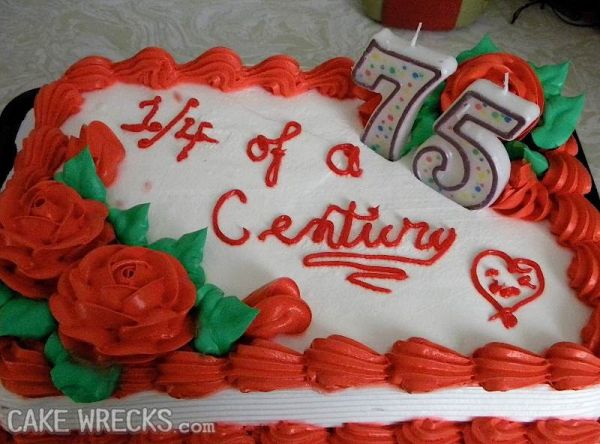
 (Photo:
(Photo: 

 4. Schrödinger's Duality of Marriage
4. Schrödinger's Duality of Marriage






 Once upon a time, movie theaters offered a "fancy night out" experience. You no longer see 50¢ tickets, but back then you got an awful lot for your money, whatever the price. Remember when almost all theaters had uniformed ushers?
Once upon a time, movie theaters offered a "fancy night out" experience. You no longer see 50¢ tickets, but back then you got an awful lot for your money, whatever the price. Remember when almost all theaters had uniformed ushers?

 (
( After years of suffering through various types of ailments, using traditional prescriptions from traditional Western doctors, and going through various procedures at Dr.'s offices and Out-Patient facilities, I felt like I was at a dead end... like nothing worked for some of these persistent problems. Then I discovered the magic of ACV, or apple cider vinegar, which has, in some cases, cured my problems and in other cases greatly reduced the issue. Now, let's be clear here, I am not a medical doctor and Neatorama does not suggest that ACV is an actual "drug" that contains "magic" properties. Nor are we in cahoots with any ACV manufacturer.
After years of suffering through various types of ailments, using traditional prescriptions from traditional Western doctors, and going through various procedures at Dr.'s offices and Out-Patient facilities, I felt like I was at a dead end... like nothing worked for some of these persistent problems. Then I discovered the magic of ACV, or apple cider vinegar, which has, in some cases, cured my problems and in other cases greatly reduced the issue. Now, let's be clear here, I am not a medical doctor and Neatorama does not suggest that ACV is an actual "drug" that contains "magic" properties. Nor are we in cahoots with any ACV manufacturer. 



 Young Charlotte Figi was born with Dravet Syndrome, a severe form of epilepsy in which the patent suffers frequent, long-lasting seizures that don't respond to medication. Charlotte spent a lot of time in various hospitals, while the seizures stunted her development.
Young Charlotte Figi was born with Dravet Syndrome, a severe form of epilepsy in which the patent suffers frequent, long-lasting seizures that don't respond to medication. Charlotte spent a lot of time in various hospitals, while the seizures stunted her development.
 Alexander Jansen is stationed in Germany and took advantage of some leave time to tour Europe with his two younger sisters. They took the train from the airport to their Dublin hotel and realized too late that Jansen's backpack was left on the train car! It had a long list of photo equipment…
Alexander Jansen is stationed in Germany and took advantage of some leave time to tour Europe with his two younger sisters. They took the train from the airport to their Dublin hotel and realized too late that Jansen's backpack was left on the train car! It had a long list of photo equipment… 

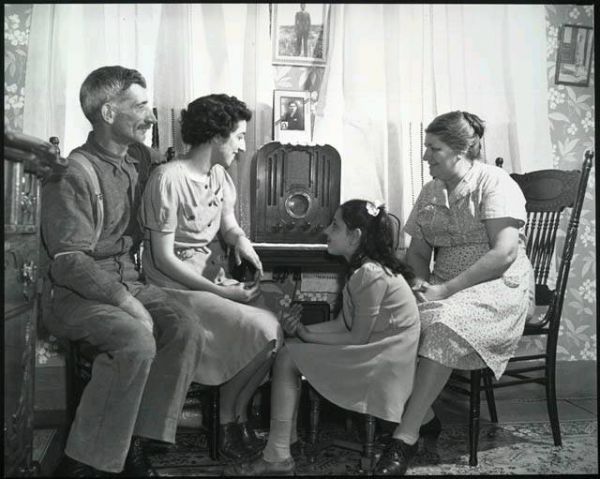

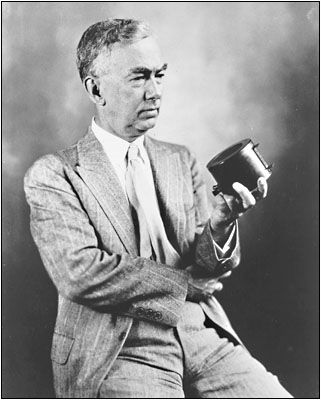 play records over the air and was soon deluged with letters from other radio operators thanking him an requesting specific songs. He couldn't honor them all, so instead he announced he would play records on Wednesday and Saturday nights, from 7:30 to 9:30 PM. After he'd gone through his own record collection a few times, a local record store offered to lend him more. Conrad returned the favor (and made history again) by telling his listeners that the records were for sale at the store. It was the first commercial ever aired.
play records over the air and was soon deluged with letters from other radio operators thanking him an requesting specific songs. He couldn't honor them all, so instead he announced he would play records on Wednesday and Saturday nights, from 7:30 to 9:30 PM. After he'd gone through his own record collection a few times, a local record store offered to lend him more. Conrad returned the favor (and made history again) by telling his listeners that the records were for sale at the store. It was the first commercial ever aired. 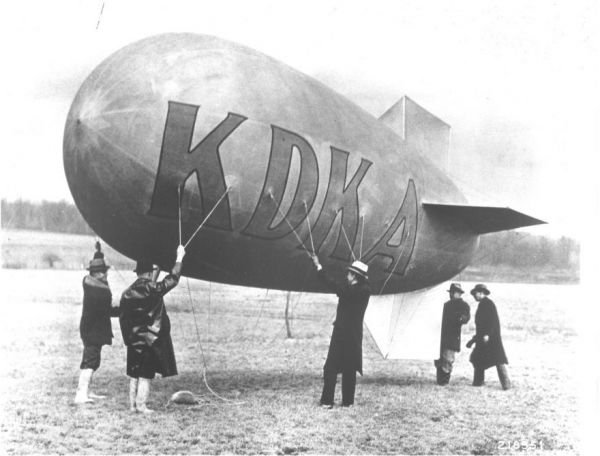
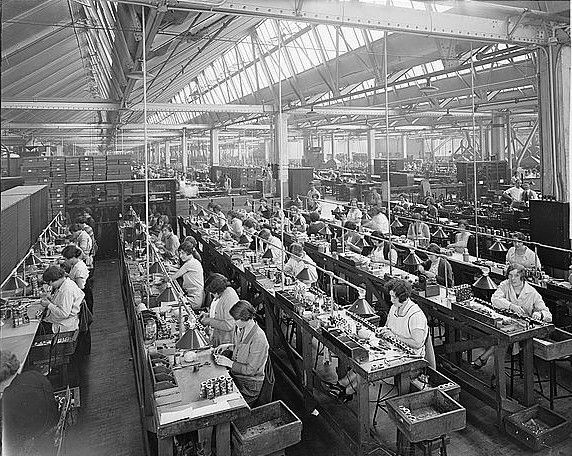
 Comedies: Comedy shows were some of the earliest hits on radio -it was easy for vaudeville stars like Jack Benny, Eddie Cantor, and the husband/wife teams of George Burns and Gracie Allen to move their acts to the new medium. At first these comedians did their usual standup routines, but over time they pioneered the "situation comedy" format that's still being used on TV today. A situation is set up at the beginning of the episode -Jack Benny has to go to the doctor, for example- then it's milked for jokes for the rest of the show.
Comedies: Comedy shows were some of the earliest hits on radio -it was easy for vaudeville stars like Jack Benny, Eddie Cantor, and the husband/wife teams of George Burns and Gracie Allen to move their acts to the new medium. At first these comedians did their usual standup routines, but over time they pioneered the "situation comedy" format that's still being used on TV today. A situation is set up at the beginning of the episode -Jack Benny has to go to the doctor, for example- then it's milked for jokes for the rest of the show. 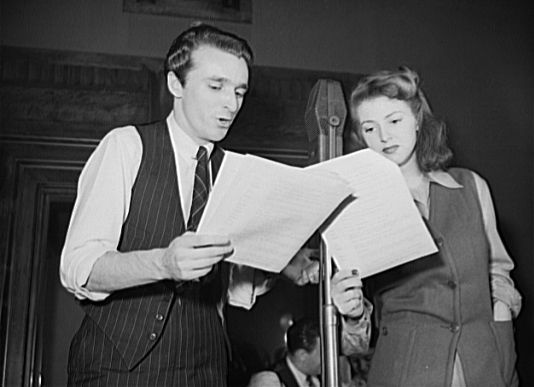
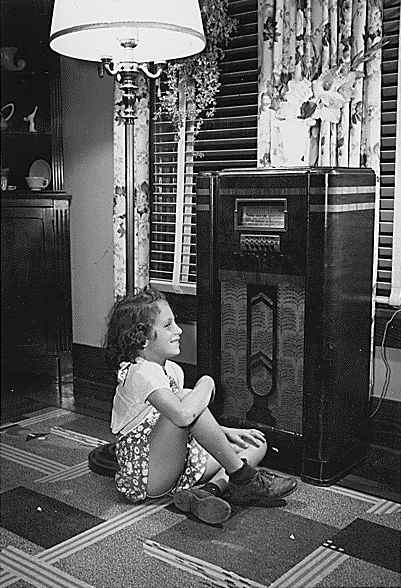 What ended the Golden Age of Radio? TV, of course. In retrospect, it's amazing that radio lasted as long as it did -both NBC and CBS began making experimental television broadcasts from their New York stations in 1939, and both stations were issued commercial licenses in 1941. Were it not for World War II, TV might have swept the country over the next few years. But when the United States entered the war, further development was halted as the stations cut their broadcasts back to nothing and TV manufacturers switched over to making electrical equipment for the war effort.
What ended the Golden Age of Radio? TV, of course. In retrospect, it's amazing that radio lasted as long as it did -both NBC and CBS began making experimental television broadcasts from their New York stations in 1939, and both stations were issued commercial licenses in 1941. Were it not for World War II, TV might have swept the country over the next few years. But when the United States entered the war, further development was halted as the stations cut their broadcasts back to nothing and TV manufacturers switched over to making electrical equipment for the war effort.  As the big advertising dollars left radio, big-budget shows became impossible to air. Many radio stations with hours of programming to fill and little money to do it went back to what radio had been in the beginning: a single person, sitting alone in a booth, playing records for anyone who happened to be listening.
As the big advertising dollars left radio, big-budget shows became impossible to air. Many radio stations with hours of programming to fill and little money to do it went back to what radio had been in the beginning: a single person, sitting alone in a booth, playing records for anyone who happened to be listening.  The article above is reprinted with permission from
The article above is reprinted with permission from 